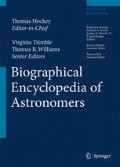Born Pabsthaus, (Sachsen‐Anhalt, Germany), 9 June 1812
Died Potsdam, Germany, 10 July 1910

Johann Galle, astronomer at Berlin and Breslau, discovered the planet Neptune and three comets, composed noted catalogs of the orbital elements for comets, and elaborated a new method to measure the solar parallax.
Galle was the eldest of seven children born to Marie Henriette and Johann Gottfried Galle, who earned a living distilling wood to obtain tar and turpentine. After successful studies at the Wittenberg Gymnasium, he matriculated at Berlin University in 1830 to study practical and theoretical astronomy. In 1835, the director of the Berlin observatory, Johann Encke, invited Galle to fill the post of his assistant. In 1845, he obtained his doctorate in astronomy from Berlin University, and was appointed as director of Breslau (now Wrocaw, Poland) Observatory in 1851. In 1856, Galle married Cäsilie Eugenie Marie Regenbrecht. Their elder son, Andreas (1858–1943), was an astronomer and geodesist, their younger son, Georg, a physician. Galle remained professionally active into very old age; he served as a professor of astronomy and observatory director at Breslau until 1897.
At the Berlin Observatory, Galle had at his disposal the high‐quality 9‐in. refractor. In June 1838, while measuring the diameter of Saturn, he discovered the crepe ring of Saturn. His search for comets was remarkably successful; in the brief interval from December 1839 to March 1840, he discovered three new comets. On 23 September 1846, Galle received a letter from the Parisian astronomer Urbain Le Verrier with his prediction of a position for the hypothetical trans‐Uranian planet. A half‐hour search on the following night yielded his discovery of an uncharted eighth‐magnitude object with a tiny disk – the giant planet Neptune.
Galle also enjoyed a solid reputation as an experienced computer. Beginning from his student years, he contributed to the Berlin astronomical ephemeris. In 1847, he published his first catalog of the orbital elements of comets; he later expanded this catalog several times. The last edition of 1894 contained the orbital elements for 414 comets. In 1872, Galle made a very useful proposal to use the minor planets to determine the Sun's parallax. He organized international campaigns for the observations of selected asteroids from different locations in order to measure an asteroid's distance from the Earth, which enabled the estimation of the Earth's distance from the Sun. This method gave the most accurate values for the astronomical unit prior to radar observations of the planets. By chance, Galle was involved in meteoritics; he carefully investigated the large rain of meteorites at Pultusk, Poland, on 30 January 1868.
In 1840, Galle won the Lalande Prize of the Paris Academy of Sciences. Today, he is remembered for his discovery of Neptune and commemorated by the naming of minor planet (2097) and craters on the Moon and Mars for him.
Selected References
Anon. (1911). “Johann Gottfried Galle.” Monthly Notices of the Royal Astronomical Society 71: 275.
Ashbrook, Joseph (1965). “The Long Career of J. G. Galle.” Sky & Telescope 30, no. 6: 355.
Chant, C. A. (1910). “Johann Gottfried Galle.” Journal of the Royal Astronomical Society of Canada 4: 379–385.
Franz, J. (1910). “Johann Gottfried Galle.” Astronomische Nachrichten 185: 309–312.
Wattenberg, Diedrich (1963). Johann Gottfried Galle, 1812–1910: Leben und Wirken eines deutschen Astronomen. Leipzig: Johann Ambrosius Barth.
Editor information
Editors and Affiliations
Rights and permissions
Copyright information
© 2007 Springer Science+Business Media, LLC.
About this entry
Cite this entry
Joeveer, M. (2007). Galle, Johann Gottfried. In: Hockey, T., et al. The Biographical Encyclopedia of Astronomers. Springer, New York, NY. https://doi.org/10.1007/978-0-387-30400-7_493
Download citation
DOI: https://doi.org/10.1007/978-0-387-30400-7_493
Publisher Name: Springer, New York, NY
Print ISBN: 978-0-387-31022-0
Online ISBN: 978-0-387-30400-7
eBook Packages: Physics and AstronomyReference Module Physical and Materials ScienceReference Module Chemistry, Materials and Physics

